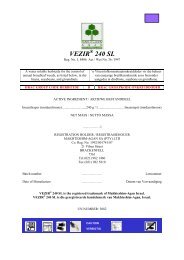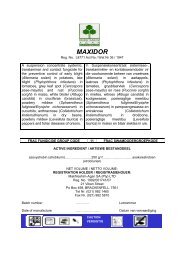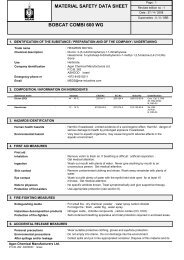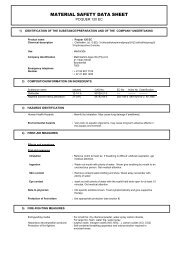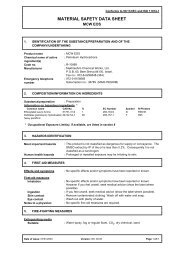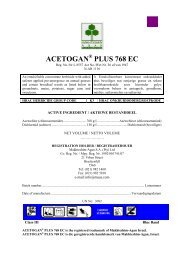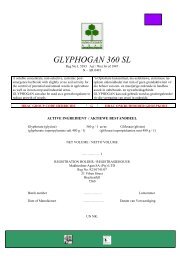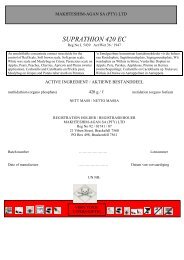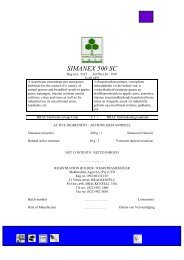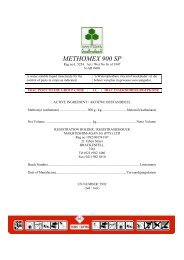Create successful ePaper yourself
Turn your PDF publications into a flip-book with our unique Google optimized e-Paper software.
<strong>CARBODAN</strong> <strong>10</strong> <strong>GR</strong><br />
Reg. No. / Nr. L 7577 Act / Wet No. / Nr. 36 of / van 1947<br />
N-AR 0911<br />
A systemic granule insecticide and nematicide<br />
for the control of pests in crops as indicated.<br />
‘n Sistemiese korrel insek- en aalwurmdoder vir<br />
die beheer van plae in gewasse soos aangedui.<br />
IRAC INSECTICIDE <strong>GR</strong>OUP CODE 1 A IRAC INSEKDODER<strong>GR</strong>OEPKODE<br />
ACTIVE IN<strong>GR</strong>EDIENT / AKTIEWE BESTANDDEEL:<br />
carbofuran (carbamate)……………………….<strong>10</strong>0 g / kg…………………..karbofuran (karbamaat)<br />
NETT CONTENTS / NETTO INHOUD<br />
…………kg…………..<br />
REGISTRATION HOLDER / REGISTRASIEHOUER:<br />
MAKHTESHIM-AGAN SA (Pty) Ltd<br />
Reg No 1992 / 001741 / 07<br />
Box / Bus 498<br />
Brackenfell<br />
7561<br />
Tel: 021 – 982 1460<br />
Fax: 021 – 982 58<strong>10</strong><br />
Batch number Lotnommer<br />
Date of manufacture Datum van vervaardiging<br />
<strong>CARBODAN</strong> <strong>10</strong> <strong>GR</strong> is the registered trade mark of <strong>Makhteshim</strong>-<strong>Agan</strong>, Israel<br />
<strong>CARBODAN</strong> <strong>10</strong> <strong>GR</strong> is die geregistreerde handelsmerk van <strong>Makhteshim</strong>-<strong>Agan</strong>, Israel<br />
HARMFUL<br />
SKADELIK<br />
<strong>GR</strong>OUP II Yellow band<br />
Carbodan <strong>10</strong> <strong>GR</strong>
WAARSKUWINGS:<br />
- AARTAPPELS:<br />
2<br />
• Dien met plant toe en moet nie binne 90 dae na toediening oes nie.<br />
- <strong>GR</strong>AANSORGHUM:<br />
• Dien slegs met plant toe.<br />
• Moet nie toelaat dat diere die behandelde sorghum bewei binne <strong>10</strong> weke na<br />
toediening nie.<br />
• Die beheer van stronkboorder mag begin afneem binne 7 – 8 weke na<br />
toediening.<br />
- KOOLGEWASSE:<br />
- MIELIES:<br />
- SUIKERRIET:<br />
• Dien slegs tydens uitplant toe en moet nie binne 11 weke na toediening oes nie.<br />
• Moet nie in kultivars wat vinnig volwassenheid bereik toedien nie.<br />
• Die beheer van ruitrugmot mag begin afneem 7 – 8 weke na toediening.<br />
• Dien slegs tydens plant toe.<br />
• Moet nie toelaat dat diere die behandelde mielies bewei of moet nie kuilvoer<br />
maak binne 8 weke na toediening onder normale reënvaltoestande nie. Indien<br />
droogtetoestande voorkom na toediening, skakel die naaste <strong>Makhteshim</strong>-<strong>Agan</strong><br />
verteenwoordiger voor die plante as voer gebruik word.<br />
• Die beheer van ruitrugmot mag begin afneem 7 – 8 weke na toediening.<br />
• Die beheer van bladspringer (vektor van streepsiekte in mielies) mag nie<br />
voldoende wees nie en streepsiekte mag nog voorkom veral in gevoelige<br />
kultivars, veral in suikermielie-variëteite en moederteellyne by saadmielies. Dit<br />
is veral die geval wanneer streepsiektedruk hoog is as gevolg van nabygeleë<br />
gasheerplante (koring, suikerriet) en mid-somer aanplantings wanneer<br />
natuurlike populasies van bladspringers hoog is en wanneer <strong>CARBODAN</strong> <strong>10</strong><br />
<strong>GR</strong> toegedien word op gronde met ‘n hoë pH.<br />
• Toediening vir die beheer van swartmieliekewer is baie krities. Verseker dat<br />
die toediener korrek gekalibreer is en gaan die vloei van korrels gereeld na<br />
gedurende toediening. Onder toestande van hoë kewerpopulasiedruk mag<br />
gewasskade van tot 20 % of meer nog voorkom na toediening.<br />
• Dien slegs tydens plant, of in die geval van oorstaanriet binne 120 dae na oes<br />
toe.<br />
• Tydens plant moet verseker word dat die steggies ten minste 7,5 cm onder die<br />
grondoppervlak geplaas word.<br />
• Dien slegs een keer per siklus toe en moet nie binne 180 dae na toediening oes<br />
nie.<br />
Carbodan <strong>10</strong> <strong>GR</strong>
- TABAK:<br />
3<br />
• Dien slegs met plant toe en nie later as een week na plant in ligte sanderige<br />
grond nie.<br />
• Moet nie in tabakplantjies wat uit saailaaie kom toedien nie.<br />
• Moet nie oes binne 80 dae na toediening nie.<br />
ALGEMENE WAARSKUWINGS:<br />
• Hanteer uiters versigtig.<br />
• Giftig indien dit met die vel in aanraking kom, ingesluk of ingeasem word.<br />
• Giftig vir visse, bye en wild. Om vergiftiging van voëls te voorkom moet<br />
gesorg word dat alle korrels onmiddellik met grond bedek word. Gee spesiale<br />
aandag aan die eindpunte van plantrye waar vermorsing mag voorkom.<br />
• Stel die werknemers in kennis van die potensiële gevaar en wat om te doen<br />
indien vergiftiging sou plaasvind. Merk die behandelde gebiede met toepaslike<br />
kennisgewings.<br />
• Verseker dat geen eetbare gewas vir minstens <strong>10</strong>0 dae binne <strong>10</strong> m van die<br />
behandelde gebied geplant word nie.<br />
• Die doeltreffendheid van <strong>CARBODAN</strong> <strong>10</strong> <strong>GR</strong> kan nadelig beïnvloed word as<br />
dit in alkaliese of brak gronde of gronde met pH > 7 gebruik word.<br />
• Moet nie <strong>CARBODAN</strong> <strong>10</strong> <strong>GR</strong> as ‘n saadbehandeling gebruik nie.<br />
• Berg agter slot en grendel en hou buite bereik van kinders, oningeligte persone<br />
en diere.<br />
• Herbetredingsinterval: Dra rubberhandskoene en rubberstewels as met<br />
behandelde grond gewerk word of as besproei word vir ten minste 30 dae na<br />
toediening.<br />
• In geval van vergiftiging RAADPLEEG ‘n GENEESHEER EN TOON<br />
HIERDIE ETIKET AAN HOM/HAAR.<br />
Alhoewel hierdie middel omvattend onder ‘n groot verskeidenheid toestande getoets is,<br />
waarborg die registrasiehouer nie dat dit onder alle toestande doeltreffend sal wees nie<br />
aangesien die werking en effek daarvan beïnvloed kan word deur faktore soos abnormale<br />
grond-, klimaats- en bergingstoestande; verenigbaarheid met ander stowwe wat nie op die<br />
etiket aangedui is nie en die voorkoms van weerstand van die plaag teen die betrokke middel<br />
sowel as die metode, tyd en akkuraatheid van toediening. Verder aanvaar die<br />
registrasiehouer nie verantwoordelikheid vir skade aan gewasse, plantegroei, die omgewing<br />
of vir nadelige effek op mens of dier of vir ‘n gebrek aan prestasie van die betrokke middel<br />
as gevolg van die versuim van die gebruiker om etiketaanwysings na te kom of as gevolg van<br />
die ontstaan van toestande wat nie kragtens die registrasie voorsien kon word nie.<br />
Raadpleeg die verskaffer in die geval van enige onsekerheid.<br />
VOORSORGMAATREËLS:<br />
• Vermy kontak met die vel of inaseming van stof.<br />
• Dra geskikte beskermende oorklere, rubberstewels en -handskoene, ‘n geskikte<br />
gesigsmakser en gesigskerm wanneer die produk hanteer word. Was besoedelde klere<br />
daagliks.<br />
• Moet nie eet, drink or rook tydens hantering, toediening of voor hande en gesig gewas is<br />
nie.<br />
Carbodan <strong>10</strong> <strong>GR</strong>
4<br />
• Was hande en gesig met seep en koue water na gebruik of as dit toevallig met die vel in<br />
aanraking kom.<br />
• Voorkom besoedeling van voedsel, voer, drinkwater en eetgerei.<br />
• Voorkom besoedeling van gebiede wat nie behandel moet word nie, gewasse, weiding,<br />
riviere, damme of enige ander waterbron.<br />
• Maak die toediener deeglik skoon na gebruik en gooi die spoelwater uit waar dit nie<br />
gewasse, weiding, riviere of damme sal besoedel nie.<br />
• Hou die leë sak oor die toediener se bak en skud dit uit.<br />
• Vernietig die leë houer en moet dit vir geen ander doel gebruik nie.<br />
• Hou persone sonder beskermende klere uit die werksgebied.<br />
Simptome van menslike vergiftiging:<br />
Hoofpyn, vermoeidheid, flouheid, duiseligheid, oormatige sweet, mislikheid, buikpyn, braking,<br />
belemmerde gesigsvermoë, spiertrekkings, gewoonlik verkleinde pupille, asemhalingsnood,<br />
bewusteloosheid.<br />
Noodhuldbehandeling:<br />
• Verwyder die pasiënt van die bron van vergiftiging en stel hom gerus en hou hom rustig.<br />
• Verwyder besoedelde klere en was besoedelde liggaamsdele met baie koue water en seep.<br />
Moet nie die vel skrop nie. Indien in oë beland het, spoel uit vir ten minste 15 minute in<br />
skoon lopende water.<br />
• Indien ingesluk veroorsaak braking deur die agterste gedeelte van die keel te prikkel met<br />
die vinger. Herhaal die proses totdat die braaksel helder is en nie meer na gif ruik nie.<br />
• Pas kunsmatige asemhaling of geslote hartmassering toe indien nodig. Moet nie direkte<br />
mond-tot-mond asemhaling toepas nie. Moet nooit iets per mond aan ‘n bewustelose<br />
persoon gee nie.<br />
• Kry onmiddellik mediese aandag.<br />
Nota aan geneesheer:<br />
Dien atropiensulfaat 2 – 4 mg (volwassene) binneaars toe. Herhaal met <strong>10</strong> minute tussenposes<br />
totdat atropinisasie intree (droë, gloeinde vel en tagikardie). Pralidoxime (2-PAM, Ptotopam) en<br />
ander oksieme moet nie gebruik word nie.<br />
Weerstandswaarskuwing:<br />
<strong>CARBODAN</strong> <strong>10</strong> <strong>GR</strong> is ‘n groepkode 1A insekdoder. Enige populasie van ‘n spesifieke insek mag<br />
individue insluit wat ‘n natuurlike weerstand teen <strong>CARBODAN</strong> <strong>10</strong> <strong>GR</strong> of enige ander groepkode<br />
1A insekdoders het. Indien hierdie insekdoders herhaaldelik aangewend word, kan die<br />
weerstandbiedende individue uiteindelik die insekpopulasie oorheers. Hierdie weerstandbiedende<br />
insekte sal waarskynlik nie deur <strong>CARBODAN</strong> <strong>10</strong> <strong>GR</strong> of enige ander groepkode 1A insekdoder<br />
beheer word nie.<br />
Om weerstand teen insekdoders te vertraag:<br />
• Vermy die eksklusiewe herhaaldelike gebruik van insekdoders met dieselfde groepkode. Wissel<br />
af met produkte in verskillende insekdodergroepkodes.<br />
• Integreer ander beheermaatreëls (chemies, verbouing, biologies) in insekdoderprogramme.<br />
Carbodan <strong>10</strong> <strong>GR</strong>
5<br />
Vir spesifieke inligting oor weerstandsbestuur kontak die registrasiehouer van hierdie produk.<br />
GEBRUIKSAANWYSINGS: Gebruik slegs soos aangedui.<br />
Algemeen:<br />
1) Dien slegs met ‘n geskikte korrek gekalibreerde korreltoediener toe en gaan die lewering<br />
van korrels gereeld na tydens toediening. Die hoek van die afvoerpype van die<br />
korreltoediener moet sodanig wees dat dit ‘n eweredige vry vloei van korrels in die<br />
plantvoor lewer. Verseker dat daar geen blokkasies in die afvoerpype voorkom nie deur dit<br />
gereeld te inspekteer.<br />
2) Genoegsame grondvog moet teenwoordig wees om die aktiewe bestanddeel te aktiveer.<br />
3) ‘n Middel soos SERVUS (Reg. Nr. L 7271) moet toegedien word vir die beheer van<br />
snywurm.<br />
4) Waar hoë infestasies van swartmieliekewer voorkom, mag die beheer daarvan nie<br />
voldoende wees nie.<br />
Verenigbaarheid:<br />
<strong>CARBODAN</strong> <strong>10</strong> <strong>GR</strong> moet nie met korrelkunsmis gemeng word en met dieselfde toediener<br />
toegedien word nie.<br />
TOEDIENINGSHOEVEELHEDE:<br />
GEWAS / PLAAG DOSIS OPMERKINGS<br />
AARTAPPELS<br />
Swartmieliekewer<br />
(Heteronychus arator)<br />
Duisendpote<br />
(Diploda spp.)<br />
<strong>GR</strong>AANSORGHUM<br />
Valsdraadwurms<br />
(Tenebrionidae spp.)<br />
Aalwurms<br />
(Verskeie spp.)<br />
200 g / <strong>10</strong>0 m<br />
lineêre rylengte<br />
<strong>10</strong>0 g / <strong>10</strong>0 m<br />
lineêre rylengte<br />
150 g / <strong>10</strong>0 m<br />
lineêre rylengte<br />
Beperkte beheer vir ‘n beperkte periode kan vir die<br />
beheer van swartmieliekewer en duisendpote verwag<br />
word. Dien slegs met plant aan weerskante van die<br />
plantvoor toe om te verseker dat die korrels eweredig<br />
met die grond bokant die saad vermeng word.<br />
Gebruik ander geregistreerde middels vir beheer later<br />
in die seisoen. Sien die verwysing onder aartappels<br />
en mielies onder WAARSKUWINGS.<br />
Dien met plant in die plantvoor toe met ‘n geskikte,<br />
korrek gekalibreerde korreltoediener. Sal ook<br />
aalwurms onderdruk. Sien die verwysing onder<br />
graansorghum onder WAARSKUWINGS.<br />
Dien met plant in die plantvoor toe met ‘n geskikte,<br />
korrek gekalibreerde korreltoediener. Sal ook<br />
valsdraadwurm beheer en stronkboorder en<br />
swartmieliekewer onderdruk. Sien die verwysing<br />
onder graansorghum onder WAARSKUWINGS.<br />
Carbodan <strong>10</strong> <strong>GR</strong>
6<br />
GEWAS / PLAAG DOSIS OPMERKINGS<br />
Stonkboorder<br />
(Busseola fusca)<br />
Stammaaier<br />
(Anatrichus erinaceus)<br />
Astylus larwes<br />
Swartmieliekewer<br />
(H. arator)<br />
KOOLGEWASSE<br />
Ruitrugmotlarwe<br />
(Plutella xylostella)<br />
Bagrada-besie<br />
(Bagrada hilaris)<br />
MIELIES en<br />
SUIKERMIELIES<br />
Valsdraadwurms<br />
(Tenebrionidae spp.)<br />
Mieliewortelwurm<br />
(Buphonella<br />
nigroviolacea)<br />
Aalwurms<br />
(Verskeie spp.)<br />
Bladspringer<br />
(Cicandulina mbila)<br />
Grondkalanders<br />
(Protostrophus spp.)<br />
Astylus larwes<br />
Stronkboorder<br />
(B. fusca)<br />
Swartmieliekewer<br />
(H. arator)<br />
SUIKERRIET<br />
Aalwurms<br />
(Verskeie spp.)<br />
200 g / <strong>10</strong>0 m<br />
lineêre rylengte<br />
200 g / <strong>10</strong>0 m<br />
lineêre rylengte<br />
<strong>10</strong>0 g / <strong>10</strong>0 m<br />
lineêre rylengte<br />
150 g / <strong>10</strong>0 m<br />
lineêre rylengte<br />
200 g / <strong>10</strong>0 m<br />
lineêre rylengte<br />
a) Plantriet:<br />
30 kg / behandelde<br />
ha<br />
Dien met plant in die plantvoor toe met ‘n geskikte,<br />
korrek gekalibreerde korreltoediener. Sal ook<br />
valsdraadwurm en aalwurms beheer. Indien ‘n hoë<br />
druk van swartmieliekewer en Astylus larwes<br />
voorkom, mag die beheer daarvan nie bevredigend<br />
wees nie. Waar sulke infestasies verwag word, moet<br />
saad met ‘n geskikte geregistreerde middel behandel<br />
word. Sien die verwysing onder graansorghum onder<br />
WAARSKUWINGS.<br />
Dien net voor uitplant in die plantvoor toe met ‘n<br />
geskikte korrek gekalibreerde korreltoediener.<br />
Verseker dat die korrels eweredig in die plantvoor<br />
versprei is. Moet nie op vinnig rypwordende kultivars<br />
gebruik nie. Sien verwysings onder koolgewasse<br />
onder WAARSKUWINGS.<br />
Dien net tydens plant in die plantvoor op die saad toe<br />
met ‘n geskikte, korrek gekalibreerde korreltoediener.<br />
Sal ook aalwurm en bladspringers onderdruk. Sien<br />
verwysings onder mielies onder WAARSKUWINGS.<br />
Dien net tydens plant in die plantvoor op die saad toe<br />
met ‘n geskikte, korrek gekalibreerde korreltoedienier.<br />
Sal ook valsdaadwurm en mieliewortelwurm beheer<br />
en stronkboorder en swartmieliekewer onderdruk.<br />
Sien verwysings onder mielies onder<br />
WAARKUWINGS.<br />
Dien slegs tydens plant in die plantvoor op die saad<br />
toe met ‘n geskikte, gekalibreerde korreltoediener.<br />
Waar hoë populasies Astylus larwes en<br />
swartmieliekewer voorkom, mag beheer daarvan nie<br />
bevredigend wees nie. Waar hoë populasies verwag<br />
word van bogenoemde plae, moet die saad behandel<br />
word met ‘n geregistreerde middel. Valsdraadwurm,<br />
mieliewortelwurm, aalwurms, bladspringers en<br />
grondkalanders sal ook beheer word deur hierdie<br />
behandeling. Sien verwysing onder mielies onder<br />
WAARSKUWINGS.<br />
Dien tydens plant in die plantvoor toe met ‘n geskikte,<br />
korrek gekalibreerde korreltoediener. Maak die<br />
plantvoor direk toe na plant. Die<br />
toedieningshoeveelheid sal afhang van die afstand<br />
tussen rye:<br />
Carbodan <strong>10</strong> <strong>GR</strong>
7<br />
GEWAS / PLAAG DOSIS OPMERKINGS<br />
ORIËNTALE TABAK<br />
(Slegs Wes-Kaap)<br />
Blaaspootjie<br />
(Thrips tabacii)<br />
TABAK<br />
Amerikaanse bolwurm<br />
(Helicoverpa armigera)<br />
WARNINGS:<br />
b) Oorstaanriet:<br />
25 kg / behandelde<br />
ha<br />
200 g / <strong>10</strong>0 m<br />
lineêre rylengte<br />
200 g / <strong>10</strong>0 m<br />
lineêre rylengte<br />
3 g / m lineêre ry vir 1,0 m rywydte<br />
3,6 g / m lineêre ry vir 1,2 m rywydte<br />
4,2 g / m lineêre ry vir 1,4 m rywydte<br />
4,8 g / m lineêre ry vir 1,6 m rywydte<br />
Dien tydens plant in die plantvoor toe met ‘n geskikte,<br />
korrek gekalibreerde korreltoediener in vlak vore (5 -<br />
<strong>10</strong> cm diep) in klam grond. Toediening kan aan een<br />
of beide kante van die plantvoor geskied. Bedek die<br />
korrels met grond. In die somer moet toediening<br />
onmiddellik na sny van riet gedoen word. In riet wat<br />
in die winter (Mei tot Augustus) gesny word, moet<br />
toediening nie later as 120 dae na sny van die riet<br />
gedoen word nie wanneer die eerste lentereën verwag<br />
word.<br />
Die dosis per lineêre meter plantry sal afhang van die<br />
rywydte:<br />
2,5 g / m lineêre ry vir 1,0 m rywydte.<br />
3,0 g / m lineêre ry vir 1,2 m rywydte.<br />
3,5 g / m lineêre ry vir 1,4 m rywydte.<br />
4,0 g / m lineêre ry vir 1,6 m rywydte.<br />
Sien die verwysing onder suikerriet onder<br />
WAARSKUWINGS.<br />
Dien tydens uitplant in die plantvoor of direk na<br />
uitplant in ‘n strook ± 8 cm breed oor die plante toe<br />
met ‘n geskikte korrek gekalibreerde korreltoediener.<br />
In sanderige gronde word voorkeur gegee om oor die<br />
plantry toe te dien mits die aktiewe bestanddeel in die<br />
grond deur reën of besproeiing geloog kan word.<br />
Moet nie op plantjies afkomstig van saailaaie gebruik<br />
nie. Knopwortelaalwurms (Meloidogyne spp.) sal ook<br />
onderdruk word. Sien die verwysings onder tabak<br />
onder WAARSKUWINGS.<br />
Dien tydens uitplant in die plantvoor toe met ‘n<br />
geskikte, korrek gekalibreerde korreltoediener. Moet<br />
nie in plantjies afkomstig van saailaaie gebruik nie.<br />
Sal Amerikaanse bolwurm vir ‘n na uitplant tydperk<br />
van 6 - 7 weke beheer. Sal knopwortelaalwurms<br />
(Meloidogyne spp.) onderdruk. Sien die verwysings<br />
on tabak onder WAARSKUWINGS.<br />
Carbodan <strong>10</strong> <strong>GR</strong>
- CABBAGES:<br />
8<br />
• Apply only at planting time and do not harvest cabbages within 11 weeks after<br />
application.<br />
• Do not use on quick maturing cultivars.<br />
• Control of Diamond back moth may start declining within 7 – 8 weeks after<br />
application.<br />
- <strong>GR</strong>AIN SORGHUM:<br />
- MAIZE:<br />
- POTATOES:<br />
- SUGARCANE:<br />
• Apply only at planting time.<br />
• Do not allow animals to feed on treated sorghum plants within <strong>10</strong> weeks of<br />
application.<br />
• Control of stalkborer may start declining 7 – 8 weeks after application.<br />
• Apply only at planting time.<br />
• Do not allow animals to feed on treated maize or make silage within 8 weeks<br />
after application under normal rainfall conditions. Should drought conditions<br />
prevail after application contact your nearest <strong>Makhteshim</strong>-<strong>Agan</strong> representative<br />
before using the plants as a fodder.<br />
• Control of stalkborer may start declining 7 – 8 weeks after application.<br />
• Leafhopper (vector of streak disease in maize) control may not be adequate and<br />
streak disease may occur especially on susceptible cultivars, particularly<br />
sweetcorn varieties and parent breeding lines in seed maize. This is particularly<br />
so when streak disease pressure is high as a result of close proximity of host<br />
plants (wheat, sugarcane) and mid-summer planting when natural populations<br />
of leafhoppers are high and <strong>CARBODAN</strong> <strong>10</strong> <strong>GR</strong> is used in soils of high pH.<br />
• Application for black maize beetle is extremely critical. Ensure applicator is<br />
correctly calibrated and flow of granules checked regularly during application.<br />
Under conditions of high beetle population pressure up to 20 % and more<br />
damage of plants may still occur after treatment.<br />
• Apply only at planting time and do not harvest within 90 days after application.<br />
• Apply only at planting time or apply on ratoon cane within 120 days after<br />
cutting previous crop.<br />
• At planting make sure that sets are placed at least 7,5 cm beneath the soil<br />
surface.<br />
• Apply only once per crop and allow at least 180 days between application and<br />
harvest.<br />
Carbodan <strong>10</strong> <strong>GR</strong>
- TOBACCO:<br />
9<br />
• Apply only at planting and not later than one week after planting in light sandy<br />
soil.<br />
• Do not apply on transplants which were grown in seed trays.<br />
• Do not harvest within 80 days after application.<br />
GENERAL WARNINGS:<br />
• Handle with extreme care.<br />
• Poisonous if it comes into contact with the skin, swallowed or inhaled.<br />
• Toxic to fish, bees and wildlife. To prevent poisoning of birds, ensure that all<br />
granules are immediately covered by soil. Take special precautions at the end<br />
of planting rows where spillage may occur.<br />
• Inform labour force of the potential danger of the product and give full<br />
instruction what to do in the case of poisoning. Mark treated areas with<br />
appropriate signs.<br />
• Ensure that no edible crop is planted within <strong>10</strong>0 days within <strong>10</strong> m from the<br />
treated area.<br />
• The efficacy of <strong>CARBODAN</strong> <strong>10</strong> <strong>GR</strong> can be adversely affected when used in<br />
alkaline or brackish soils with a pH > 7.<br />
• Do not use <strong>CARBODAN</strong> <strong>10</strong> <strong>GR</strong> as a seed treatment.<br />
• Keep under lock and key and out of reach of children, uninformed persons and<br />
animals.<br />
• Re-entry interval: Wear rubber gloves and boots when working with treated<br />
soil or irrigating, for at least 30 days after application.<br />
• In case of poisoning CALL A DOCTOR AND MAKE THIS LABEL<br />
AVAILABLE TO HIM/HER.<br />
Although this remedy has been extensively tested under a large variety of conditions, the<br />
registration holder does not warrant that it will be efficacious under all conditions because<br />
the action and effect thereof may be affected by factors such as abnormal soil, climatic and<br />
storage conditions, compatibility with other substances not indicated on the label and the<br />
occurrence of resistance of the pest to the remedy concerned as well as by the method, time<br />
and accuracy of application. The registration holder furthermore does not accept<br />
responsibility for damage to crops, vegetation, the environment or harm to man or animal, or<br />
for lack of performance of the remedy concerned due to failure of the user to follow the label<br />
instructions, or to the occurrence of conditions which could not have been foreseen in terms<br />
of the registration. Consult the supplier in the event of any uncertainty.<br />
PRECAUTIONS:<br />
• Avoid skin contact and the inhalation of dust.<br />
• Wear suitable protective clothing, rubber boots and gloves, a suitable respirator and face<br />
shield when handling the product. Wash contaminated clothing daily.<br />
• Do not eat, drink or smoke during handling, applying or before washing hands and face.<br />
• Wash hands and face with soap and cold water after use or in case of accidental skin<br />
contact.<br />
• Prevent contamination of food, feed, drinking water and eating utensils.<br />
Carbodan <strong>10</strong> <strong>GR</strong>
<strong>10</strong><br />
• Prevent contamination of areas that are not under treatment, crops, grazing, rivers, dams or<br />
any other water source.<br />
• Clean applicator thoroughly after use and dispose of wash water where it will not<br />
contaminate crops, grazing, rivers or dams.<br />
• Empty container completely by shaking it over the applicator’s hopper.<br />
• Destroy the empty container and do not re-use for any other purpose.<br />
• Keep unprotected persons away from operating area.<br />
Symptoms of human poisoning:<br />
Headache, fatigue, faintness, giddiness, excessive sweating, nausea, abdominal pain, vomiting,<br />
blurred vision, muscle twitching, usually small pupils, respiratory distress and coma.<br />
First aid treatment:<br />
• Remove patient from source of poisoning and keep patient quiet and reassured.<br />
• Remove contaminated clothing and wash contaminated body area with plenty of cold water<br />
and soap. Do not rub skin. If in eyes rinse out for at least 15 minutes in clean running<br />
water.<br />
• If swallowed induce vomiting by tickling the back part of the throat. Repeat until vomit is<br />
clear and free from smell of poison.<br />
• Administer artificial respiration or closed cardiac massage if necessary. Do not apply<br />
direct mouth-to-mouth respiration. Never give anything by mouth to an unconscious<br />
person.<br />
• Get medical attention immediately.<br />
Note to physician:<br />
Give atropine sulphate 2 – 4 mg (adult) applied intravenously, repeated by <strong>10</strong> minute intervals until<br />
atropinization (dry, flushed skin and tachycardia) appears. Pralidoxime (2-PAM, Protopam) and<br />
other oximes are contra-indicated.<br />
Resistance warning:<br />
For resistance management, <strong>CARBODAN</strong> <strong>10</strong> <strong>GR</strong> is a group code 1A insecticide. Any insect<br />
population may contain individuals naturally resistant to <strong>CARBODAN</strong> <strong>10</strong> <strong>GR</strong> and other group<br />
code 1A insecticides. The resistant individuals can eventually dominate the insect population if<br />
these insecticides are used repeatedly. These resistant insects may not be controlled by<br />
<strong>CARBODAN</strong> <strong>10</strong> <strong>GR</strong> or any other group code 1A insecticide.<br />
To delay insecticide resistance:<br />
• Avoid exclusive repeated use of insecticides from the same insecticide group code. Alternate<br />
with products from different insecticide group codes.<br />
• Integrate the control methods (chemical, cultural, biological) into insect control programmes.<br />
For specific information on resistance management contact the registration holder of this product.<br />
Carbodan <strong>10</strong> <strong>GR</strong>
11<br />
DIRECTIONS FOR USE: Use only as indicated.<br />
General:<br />
1) Apply only by using a correctly calibrated granular applicator. Check delivery of granules<br />
several times during application. The downpipes of the applicator should be set at an angle<br />
which ensures a free, even flow of granules into the plant furrow. To avoid blockages<br />
regular checks should be made.<br />
2) Sufficient soil moisture must be present to activate the active ingredient.<br />
3) A remedy like SERVUS (Reg. No. L 7271) should be applied for the control of cutworm.<br />
4) Under conditions of high pressure, black maize beetle might not be controlled sufficiently.<br />
Compatibility:<br />
<strong>CARBODAN</strong> <strong>10</strong> <strong>GR</strong> should not be mixed with granular fertilizer and applied with the same<br />
applicator.<br />
APPLICATION RATES:<br />
CROP / PEST DOSAGE REMARKS<br />
CABBAGE<br />
Diamond back moth<br />
larvae<br />
(Plutella xylostella)<br />
Bagrada bug<br />
(Bagrada hilaris)<br />
<strong>GR</strong>AIN SORGHUM<br />
False wire worms<br />
(Tenebrionidae spp.)<br />
Nematodes<br />
(Various spp.)<br />
Stalkborer<br />
(Busseola fusca)<br />
Shootfly<br />
(Anatrichus erinaceus)<br />
Astylus larvae<br />
Black maize beetle<br />
(Heteronychus arator)<br />
200 g / <strong>10</strong>0 m<br />
linear row<br />
<strong>10</strong>0 g / <strong>10</strong>0 m linear<br />
row<br />
150 g / <strong>10</strong>0 m linear<br />
row<br />
200 g / <strong>10</strong>0 m<br />
linear row<br />
Apply immediately before transplanting with a<br />
correctly calibrated granular applicator. Ensure that<br />
the granules are distributed evenly in the plant<br />
furrow. Do not use on quick maturing varieties.<br />
Refer to section under Cabbages under WARNINGS.<br />
Apply at planting in the plant furrow with a correctly<br />
calibrated granular applicator. Will also suppress<br />
nematodes. Refer to section under grain sorghum<br />
under “WARNINGS”<br />
Apply at planting in the plant furrow with a correctly<br />
calibrated granular applicator. Will also control false<br />
wire worm and suppress stalk borer and black maize<br />
beetle. Refer to section under grain sorghum under<br />
“WARNINGS”.<br />
Apply at planting in the plant furrow by means of a<br />
correctly calibrated granular applicator. Will also<br />
control false wire worm and nematodes. Under<br />
conditions of high infestation levels black maize<br />
beetle and Astylus, control might not be sufficient.<br />
Where high infestations are expected, seed should be<br />
treated with a suitable registered remedy. Refer to<br />
section under grain sorghum under “WARNINGS”<br />
Carbodan <strong>10</strong> <strong>GR</strong>
12<br />
CROP / PEST DOSAGE REMARKS<br />
MAIZE and<br />
SWEETCORN<br />
False wire worms<br />
(Tenebrionidae spp.)<br />
Maize rootworm<br />
(Buphonella<br />
nigroviolacea)<br />
Nematodes<br />
(Various spp.)<br />
Leafhopper<br />
(Cicadulina mbila)<br />
Ground weevils<br />
(Protostrophus spp.)<br />
Astylus larvae<br />
Stalk borer<br />
(B. fusca)<br />
Black maize beetle<br />
(H. arator)<br />
POTATOES<br />
Black maize beetle<br />
(H. arator)<br />
Millipedes<br />
(Diploda spp.)<br />
SUGAR CANE<br />
Nematodes<br />
(Various spp.)<br />
<strong>10</strong>0 g / <strong>10</strong>0 m<br />
linear row<br />
150 g / <strong>10</strong>0 m<br />
linear row<br />
200 g / <strong>10</strong>0 m<br />
linear row<br />
200 g / <strong>10</strong>0 m<br />
linear row<br />
a) Plant cane:<br />
30 kg / treated ha<br />
b) Ratoon cane:<br />
25 kg / treated ha<br />
Apply only at planting in the plant furrow onto seed<br />
by means of a correctly calibrated granular<br />
applicator. Will also suppress nematodes and<br />
leafhopper. Refer to section under Maize under<br />
“WARNINGS”<br />
Apply only at planting in the plant furrow onto seed<br />
by means of a correctly calibrated granular<br />
applicator. Will also control false wire worm and<br />
maize root worm and suppress stalk borer and black<br />
maize beetle. Refer to section under maize under<br />
WARNINGS.<br />
Apply only at planting in the plant furrow onto seed<br />
by means of a correctly calibrated granular<br />
applicator. Under conditions of high population<br />
pressure of Astylus larvae and black maize beetle,<br />
control might not be sufficient. Where high infection<br />
pressures of the above mentioned pests are expected,<br />
the seed should be treated with a registered remedy.<br />
False wire worm, maize root worm, nematodes,<br />
leafhoppers and ground weevils will be controlled by<br />
this treatment. Refer to section under maize under<br />
“WARNINGS”<br />
Limited control for a limited period of time can be<br />
expected for the control of black maize beetle and<br />
Millipedes. Apply only at planting on both sides of<br />
the plant furrow to ensure thorough mixing of the<br />
granules with the soil above the seed. Use other<br />
registered chemicals for further control later in the<br />
season.<br />
Refer to section under potatoes and maize under<br />
WARNINGS.<br />
Apply at planting in the plant furrow by means of a<br />
suitable correctly calibrated granular applicator.<br />
Cover furrow immediately after planting. The rate per<br />
linear meter plant row depends on the row spacing:<br />
3,0 g / m linear row for 1,0 m spacing<br />
3,6 g / m linear row for 1,2 m spacing<br />
4,2 g / m linear row for 1,4 m spacing<br />
4,8 g / m linear row for 1,6 m spacing<br />
Apply by means of a suitable correctly calibrated<br />
granular applicator in a shallow furrow (5 - <strong>10</strong> cm<br />
deep) in moist soil to one or both sides of the furrow.<br />
Carbodan <strong>10</strong> <strong>GR</strong>
13<br />
CROP / PEST DOSAGE REMARKS<br />
ORIENTAL TOBACCO<br />
(Western Cape only)<br />
Thrip<br />
(Thrips tabacii)<br />
TOBACCO<br />
American bollworm<br />
(Helicoverpa armigera)<br />
200 g / <strong>10</strong>0 m<br />
linear row<br />
200 g / <strong>10</strong>0 m<br />
linear row<br />
Cover granules with soil. Application should take<br />
place in summer immediately after cutting the crop<br />
while in crops cut in winter (May to August),<br />
application should take place not later than 120 days<br />
after cutting the crop when the first spring rain is<br />
expected.<br />
The rate per linear meter plant row depends on the<br />
row spacing:<br />
2,5 g / m linear row for 1,0 m spacing.<br />
3,0 g / m linear row for 1,2 m spacing.<br />
3,5 g / m linear row for 1,4 m spacing.<br />
4,0 g / m linear row for 1,6 m spacing.<br />
Refer to section under sugarcane under WARNINGS.<br />
Apply at transplanting in the plant furrow or<br />
immediately after planting in a band ± 8 cm wide<br />
over the plants by means of a suitable correctly<br />
calibrated granular applicator. Where sandy soils<br />
occur preference is given to applying over the plant<br />
row provided the active ingredient is leached into the<br />
soil by rain or overhead irrigation. Do not use on<br />
transplants from seed trays. Root knot nematodes<br />
(Meloidogyne spp.) will also be suppressed. Refer to<br />
section under tobacco under WARNINGS.<br />
Apply at transplant in the plant furrow by means of a<br />
suitable correctly calibrated granular applicator. Do<br />
not use on transplants from seed trays. Will control<br />
bollworm for a period of up to 6 - 7 weeks after<br />
planting. Will suppress root knot nematodes<br />
(Meloidogyne spp.) Refer to WARNINGS in the<br />
tobacco section.<br />
Carbodan <strong>10</strong> <strong>GR</strong>



